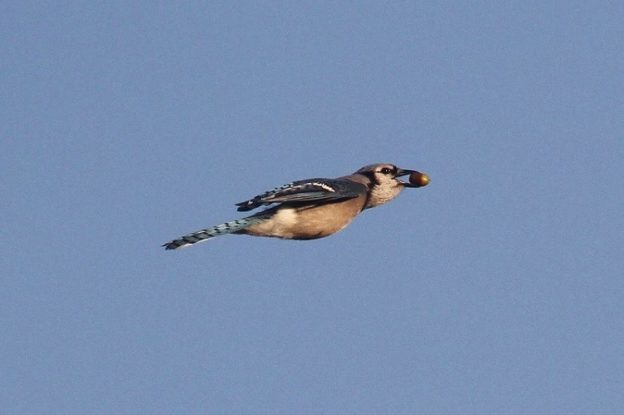Fall holidays mean family gatherings – for people and for Blue Jays. Much like people, these highly social birds are more active in the fall, when the harvest is good and families are reuniting. This pattern is borne out by data on eBird, when observers’ Autumn checklists show a spike in sightings. Here are a few explanations for jays’ noisy behavior right now.

Predators on the move mean agitated birds
When there is a predator nearby, many birds exhibit mobbing behavior to warn others of the threat. This means loud calling and erratic flight patterns. During migration, higher numbers of hawks, owls, and falcons may excite young jays and cause them to vocalize more frequently.
Blue Jays have also been known to imitate hawk calls. Some researchers think this is a signal to their flock of a potential threat nearby. Others believe Blue Jays are cleverly trying to scare other birds away from their food source. Ross D. James, in a 2002 edition of Ontario Birds, theorizes that young birds learn raptor calls during periods of high stress and excitement and therefore will reproduce them under those same conditions.
Acorns are plentiful

Every two to five years, Oak trees drop their acorns in much higher abundance than usual. These periods of higher acorn production are called “mast years” and greater Boston residents have taken notice. Fortunately for Blue Jays, who eat mostly seeds, this means lots and lots of food. They flock to areas with high densities of Oak trees, like many Massachusetts forests, and call out to their kin that they’ve hit the jackpot.
Winter flocks are recruiting
Blue Jays are winter residents in Massachusetts. Some individuals do migrate, but little is known about how or why they decide to do so. Families group together in large flocks starting in the fall. These flocks are constantly communicating potential threats and food sources since fledglings are still learning the ropes.
One study of Blue Jays at Mass Audubon’s Wachusett Meadow Wildlife Sanctuary observed wintering jay groups of 14-49 individuals. These birds tended to stay in the same groups throughout the winter and in subsequent years.

Have you noticed more Blue Jay activity lately? Let us know in the comments!


